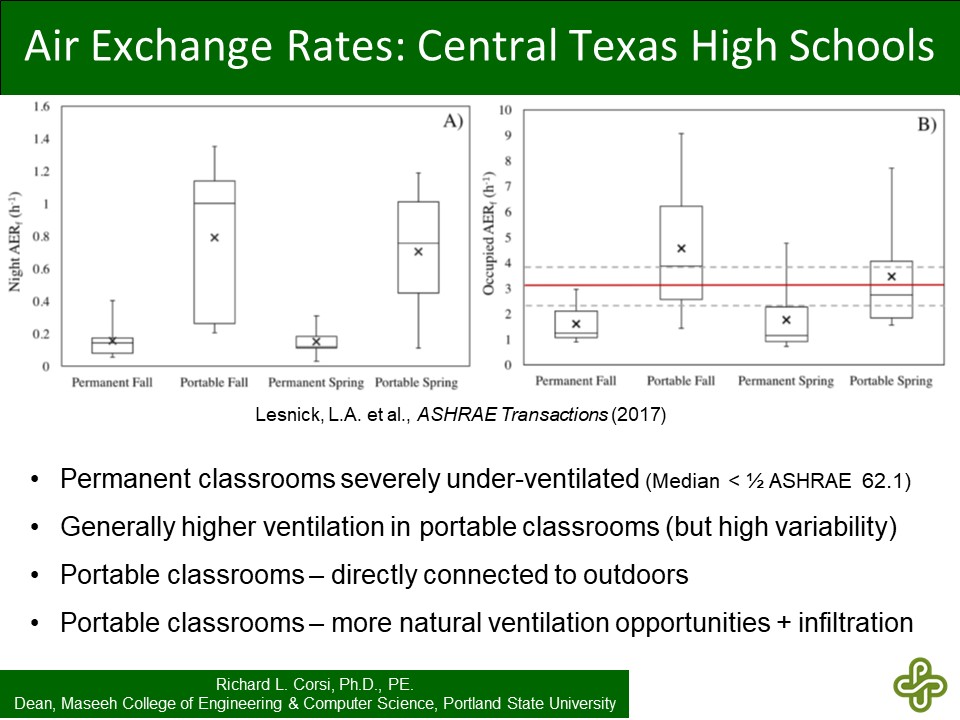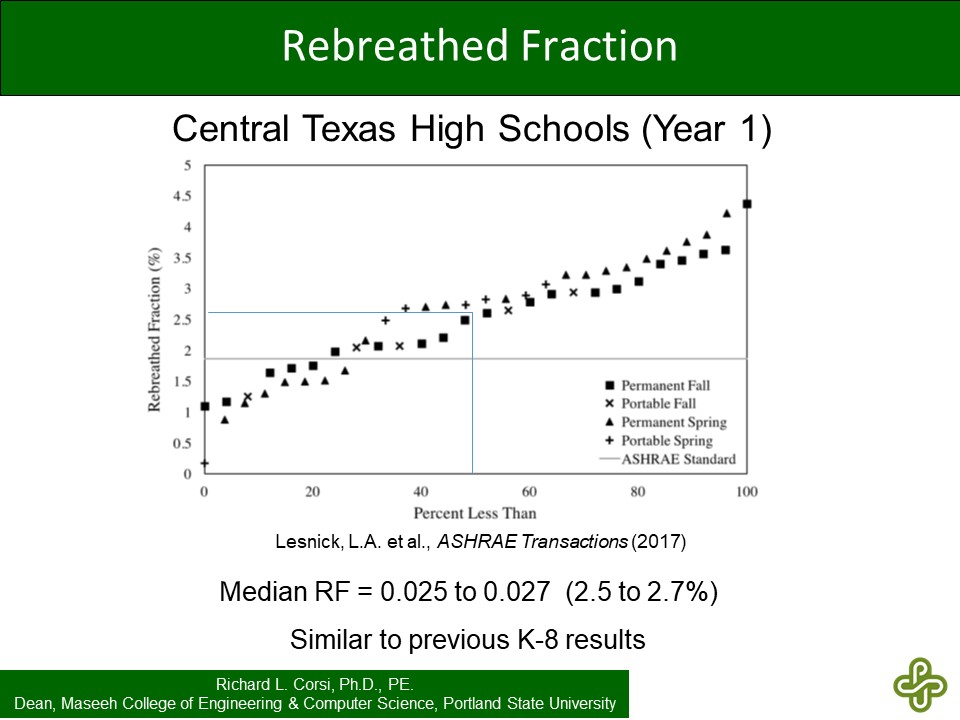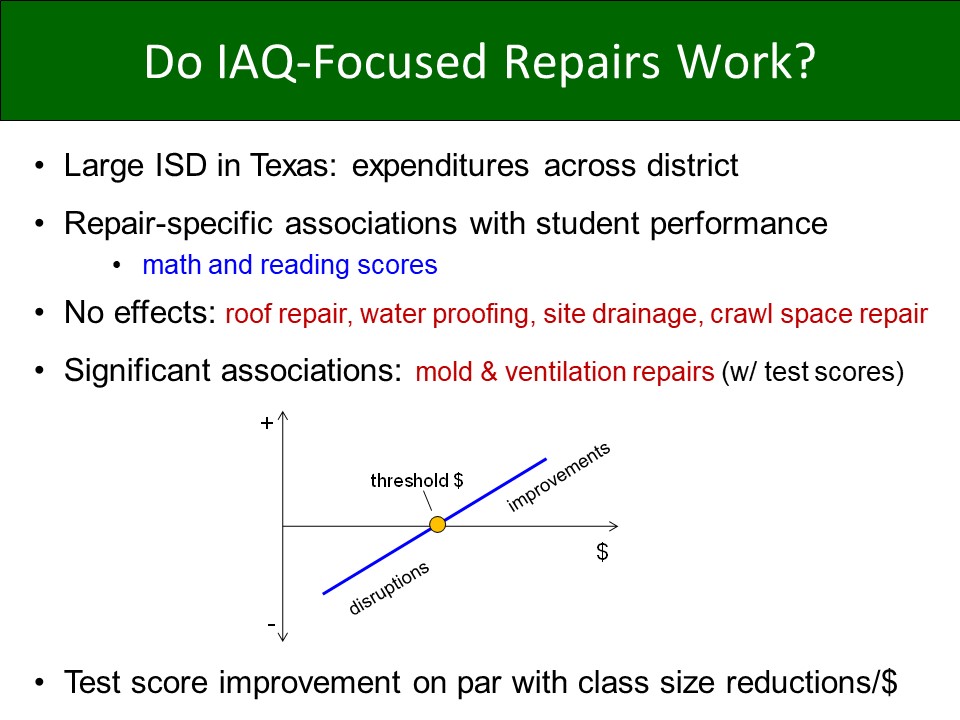1/ Ventilation of Schools. My experience working with public school districts for more than two decades is that classrooms are, in general, woefully underventilated (and that's before COVID-19 times!). Others have found the same.
2/ Some results from a 4-yr study involving 7 high schools of different ages & construction, & 46 classrooms (focus on occupied day - plot at right). Approx 80% of classrooms = permanent. Red bar shows approx ASHRAE 62.1-2019 ventilation rate (small variations around bar).
2/ For permanent classrooms, median ventilation rates are less than 50% of ASHRAE 62.1-2019, w/ mean values approx 40% lower. Schools all had mechanical systems and capability of much greater ventilation. When asked why, our team was told (firmly) - energy savings ($$).
3/ Another way of looking at this is in terms of rebreathed fraction of air (here represented as % as opposed to fraction) of inhaled air that came out of the collective respiratory systems of others in the space. We want this to be LOW to reduce infections by aerosol particles.
4/ Here is a cumulative distribution plot of rebreathed fraction (RF) for classrooms. The median RF = 2.5 - 2.7% between fall and spring sessions. This can be thought as every 40th inhaled breath being entirely an ensemble collection of exhaled breath from everyone in the space.
5/ In a previous tweet I suggested that we aim for RF < 0.008 (less than 0.8%) to significantly reduce risk of infection by aerosol transmission in classrooms (but there is still risk). In this case, only two classrooms meet threshold. Large increases in ventilation needed.
6/ Not requiring masks, physical distancing, lower occupancy, AND AND AND much GREATER VENTILATION in these classrooms is a recipe for infection.
7/ Many years ago I had the honor of serving as director of an NSF-funded IGERT program entitled Indoor Environmental Science and Engineering: An Emerging Frontier. A generation of indoor air quality experts who remain active in research (& twitter) went through that program.
8/ One was an economics student, Dr. Tess Stafford, who did a great dissertation that focused, in part, on student performance on standardized tests and renovations done across schools in a very large school district. A really unique study w/ ample support by the district.
9/ The abstract for Tess' work is at https://www.sciencedirect.com/science/article/abs/pii/S0095069614001016
I have summarized below in an image. Note that the ONLY two types of renovations that improved student test scores were mold remediation and VENTILATION REPAIRS.
I have summarized below in an image. Note that the ONLY two types of renovations that improved student test scores were mold remediation and VENTILATION REPAIRS.
10/ Many of the renovations were actually detrimental to test scores due to disruptions of the classroom environment (noise, dust, etc.). And there was a strong relationship between size of effort (in $$) and test scores.
11/ The upshot of all of this is that proper ventilation of schools matters, a lot! It did before COVID, it definitely does during COVID, and it will after COVID. It deserves more than a passing do it if you can from @CDC.
12/ School districts around the country are about to get a large infusion of funding to try to make their schools safer (not entirely safe) during COVID-19, and use of those funds could help after COVID-19 as well.
13/ There is HIGH potential for districts to squander these funds if they continue to get wishy-washy messaging from health authorities & slick marketing from companies that pedal unproven approaches & technologies.
14/ In addition to masks, distancing, lowering occupancy (innovate), testing if possible, investments should be made to improve & increase ventilation (whether mechanical systems currently exist or not) ....
15/ Improve central filtration where necessary, and employ single-zone portable HEPA filtration (appropriately sized and w/o add-ons - just "HEPA Classic"), which yields an effective equivalent increase in ventilation.
16/ @j_g_allen and I published an Op-Ed in WA Post last summer (seems like three lifetimes ago). We estimated that cap cost would be approx $1 billion to equip every public school classroom in US with a very good portable HEPA filtration system. Every classroom!
17/ There would be recurring costs at approx $0.3 billion/year (likely much lower w/ bulk discounts). The manufacturing capacity is there, and we also know that it is possible to build your own portable filtration system if needed. Cool community project.
18/ These figures might seem high, but they are a small drop in the bucket of the funds that will be coming to schools soon. You'd think that a small investment in single-zone equivalent ventilation increases would be a no brainer -- but no mention by @CDC.
19/ Much, much more $$ will be available for improved VENTILATION, & perhaps central filtration upgrades, upper-room UVGI in some cases, & other efforts to make schools safer & healthier in future. Schools need better guidance than CDC is providing. Incredibly disappointing.

 Read on Twitter
Read on Twitter




